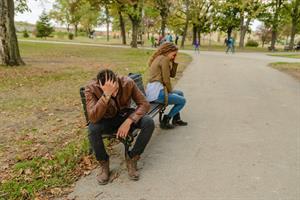
PUMPA - SMART LEARNING
எங்கள் ஆசிரியர்களுடன் 1-ஆன்-1 ஆலோசனை நேரத்தைப் பெறுங்கள். டாப்பர் ஆவதற்கு நாங்கள் பயிற்சி அளிப்போம்
Book Free DemoWe hated one another.
The afternoon turned black.
Then suddenly my brother
Thumped me on the back,
And said, “Oh, come along!
We can’t go on all night —
I was in the wrong.”
So he was in the right.
Then suddenly my brother
Thumped me on the back,
And said, “Oh, come along!
We can’t go on all night —
I was in the wrong.”
So he was in the right.
Explanation:

Suddenly all those moments of brotherly and sisterly love are lost (Image for illustrative purpose only)
There is a sudden shift in the dark mood of the poet, and her brother as in lines \(11\) and \(12\) her brother takes the first step towards both brother and sister becoming caring, friendly and loving siblings again by thumping Eleanor on the back. Her brother is unable to hold the grudge of anger anymore and simply tells her the truth that no matter what the disagreement between them, they cannot hold a grudge against each other all night. This shows that even though the fight seemed big and dangerous, it was only a short amount of time that they could be angry at each other because after all, they are brother and sister and cannot live without one another. These are the feelings of the brother in lines \(13\) and \(14\).

The best siblings are ones who set apart their differences and continue to love each other (Image for illustrative purpose only)
Finally, we can see that Eleanor also agrees with her brother to let the silly fight go. In the last two lines (\(15\) &\(16\)) she said that she was wrong to be angry with her brother and since her brother wants this fight to end and their relationship as brother and sister to continue, the brother first agrees that he was wrong and told Eleanor that she was right. The beauty of the last two lines is that in the last line (line \(16\)), she realizes that she had been equally wrong in thinking that she could keep on fighting with her brother. At this moment, the entire quarrel seems pointless and its result, whether the brother was right or the sister, didn't seem important anymore. Hence, she immediately drops the fight, and both brother and sister become friendly once again.

They were born into the same family after all! (Image for illustrative purpose only)
Meanings of difficult words:
| No. | Word | Meaning |
1 | To be absorbed | Giving all of a person's attention to the matter. |
2 | Dusk | Another word for evening. |
3 | Thumping | A friendly pat, generally on the back. |
4 | Grudge | To hold anger against a person. |
Hidden meanings: Sometimes, in a poem, the same set of lines can be seen in two different meanings. Both meanings would be correct and aptly fit into the lines that are written by the poet, in this poem looking at line no. \(10\).
Example:
'The afternoon turned black.'
Reference:
National Council of Educational Research and Training (2006). Honeysuckle. The Quarrel (pp. 39-40). Published at the Publication Division by the Secretary, National Council of Educational Research and Training, Sri Aurobindo Marg, New Delhi.